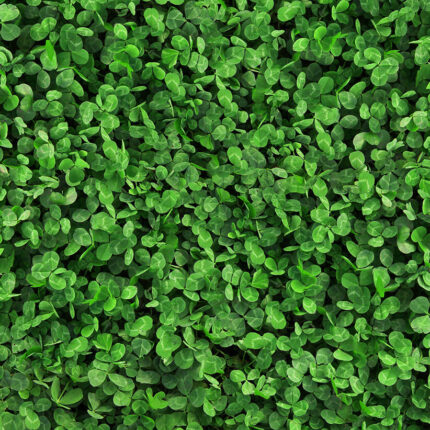Classy Clover: The Best Addition to Your Lawn

White clover is one of the unsung heroes of the modern home landscape. While its virtues remained largely ignored for many decades, we are now talking about it again.
Healthy Honeybees, Healthy Environment
Most of us have heard about clover honey, but how many of us have heard that clover is a great source of good quality protein for bees? Most of it goes to workers developing in the comb, but it is also vital to a healthy queen. Without good protein, worker bees and queens develop small and have shorter life spans.
Free Fertilizer
Clover has a give-and-take relationship with special bacteria that form colonies in clover’s roots. The clover gives the bacteria a little energy in the form of sugar, and in return the bacteria take nitrogen out of the air and shares it with the clover. As the clover ages and gets trimmed, some of the roots die back and the nitrogen gets released for other plants to use. So, if you plant clover in your lawn you get nitrogen for the life of your lawn; all for the small investment of seeding it in.
Improves Soil Structure & Quality
White clover also sends down deep taproots. These deep roots help break up compacted soil and add needed organic material to deeper layers of soil. After a year or two, the taproot dies and leaves a channel for water to penetrate deeper into the soil.
Helps Lawn Stay Green During Drought Stress
I have personally noted that during a drought year when the rest of the grass is suffering and brown for lack of water, grass growing with the clover is as green and healthy as the clover is. I have not seen references to this in any science articles, but friends of mine have noticed the same pattern.
Pure Clover Lawns vs. Clover/Grass Mixes
Pure clover lawns have become hip in some circles, but I think mixing it with turfgrass to create a polyculture is a healthier and more attractive option. Clover doesn’t always have strong roots when it sprouts, so having a grass with stronger roots while the clover is young is a good practice. Clover also goes well with other broad leaf plants in a creative lawn mix. I have yarrow growing fabulously next to my largest clover patch.
How To Add Clover to Your Lawn
Clover can be planted at any point in the growing season, but it does appreciate the cool, moist spring and fall seasons. The best time to plant clover in an existing lawn is in the spring right after aeration. If you mow your lawn low beforehand, it will help the seed get all the way down to the soil. If you are not aerating for some reason you can still plant clover, it is just more manual work:
1. Mow low as you can.
2. Rake the grass deeply with a garden rake so the soil gets disturbed.
3. Toss seed on top.
4. Rake again.
Raking deep enough is not going to be easy, so plan for enough time and skip the day’s arm workout. You won’t need it! With either method, remember that any seedling needs extra water while establishing. If spring rains are short in your area, turn on the irrigation system or plan on a little extra hose dragging.
White clover is a great addition to your lawn and a great addition to your neighborhood. If you have a unique clover project please send us the story and a few photos. We love seeing the great things our clients are doing!
Manana!


